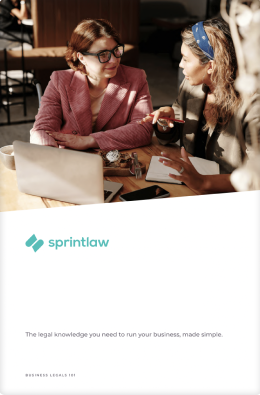Contents
When you think about protecting your brand, often the first thing that comes to mind is your name and logo.
However, your slogan or tagline can also play a huge role in how customers identify you.
Whether it’s the McDonald’s “I’m lovin’ it” or the Toyota “Oh, what a feeling” – we can all think of a company that we immediately recognise just by their tagline.
It’s a powerful way to stand out to your customers.
So if your business has a creative and distinctive slogan or tagline, how do you stop your competitors from copying it?
Answer: Get a trade mark.
What Is A Trade Mark?
A trade mark is a type of “Intellectual Property” (or IP for short). That is, property that’s intangible (unlike, for example, a house or car).
If you’re starting a business, it’s likely that you’ve heard of IP before.
There are different types of IP that protect the different intangible assets of your business. Trade marks are one type, used to protect your business’ image, brand and reputation.
When you register a trade mark with IP Australia, you get the exclusive legal right to use the registered trade mark, for certain classes of business activities.
This means you have the right to take legal action against anyone using your trade mark.
What Does A Trade Mark Protect?
A trade mark is usually the name of a business, a logo – or a slogan.
A trade mark can actually take many other forms such as a shape, colour, sound or scent. It can basically be anything that allows you to distinguish yourself from other businesses.
That’s why a trade mark is great for tagline or slogan protection: It is designed to protect things that make your brand stand out to customers.
Is A Trade Mark Worth It?
It’s not compulsory to register a trade mark for your business. It’s a decision that you have to make.
If you’re not sure whether you need to register a trade mark, you can ask yourself:
- How do your customers recognise your brand?
- Do they recognise your business name, logo, slogan, tagline or all of the above?
Thinking about how your customers recognise you is an important step to discovering what your most valuable brand assets are.
If your slogan or tagline is a big part of your brand identity and you want to protect it, you should consider registering a trade mark.
If your business name or logo are distinctive aspects of your brand, you should look at getting trade marks for those as well.
Basically: If you really want to protect your brand and reputation, you should register a trade mark.
Another key benefit of registering a trade mark is that you know that you are not the one infringing on someone else’s mark.
How devastating would it be if you go about your business using your current slogan and have a lot of success, only to get hit with a lawsuit a few years later by the registered trade mark owner?
If you had registered the trade mark for your slogan in the first place, you would have discovered that another similar trade mark already existed. Then you could’ve avoided a huge headache for your business.
How To Trade Mark A Slogan
The next obvious question is: How do you trade mark a slogan?
Thankfully, how to trade mark a tagline or slogan is not that different to any other type of trade mark.
Registering a trade mark can be a confusing process. We’ve broken it down into 4 steps:
- Deciding on your trade mark
- Deciding on your classes of goods or services
- Making your application
- Completing the registration
We go into each of these steps in plenty of detail in our article all about the basics of trade marks.
Here’s a quick overview:
1. Deciding on your trade mark
This step is easy – If you’re going to trade mark your slogan or tagline, make sure you’re decided on what it is.
At this stage, it’s a good idea to do a thorough search on Google and the Australian Trade Mark Search to make sure that no one else is using a similar trade mark.
2. Deciding on your classes of goods or services
Remember when we said that a trade mark gives you the exclusive right to use the registered trade mark for certain classes of business activities?
When you’re applying to register a trade mark, you need to choose the classes of goods and services you want to register your trade mark in.
This limits the scope of your registration to the goods and services that you actually trade in.
The reason for this is to give businesses in different industries more options for what to register. It would be unfair to register a trade mark in an industry where you had no intention whatsoever to do business!
Choosing the right class or classes can be a tricky process, so it’s a good idea to seek legal advice at this point. That way, you know you’re choosing the right class from the outset, getting the best protection for your trade mark and you won’t have to make another application down the track.
3. Making Your Application
Once you’ve decided on your trade mark and the classes you want to register, you’re ready to make your application.
There are 2 ways to apply for a trade mark online with IP Australia – either through the TM Headstart process, or the standard application process.
4. Completing the Registration
After you make the initial application, the entire process for registering a trade mark can take 7-8 months.
Once IP Australia has finished processing the application and there are no issues, you will have a registered trade mark – congratulations!
What to Take Away…
If you’ve developed an awesome tagline or slogan – don’t let it go to waste!
If you protect your slogan with a trade mark, you can leverage it to get the best results for your business, without your competitors copying you.
It is certainly possible to register a trade mark yourself online, but if you want to make sure you’re doing it correctly, it’s a good idea to speak to a lawyer.
More often than not, getting professional advice about your trade mark is the safest option and often ends up being cheaper in the long run.
If you’d like assistance with registering a trade mark or protecting your IP, get in touch and we’d love to speak to you about your enquiry!
Get in touch now!
We'll get back to you within 1 business day.













0 Comments on "How Do You Protect Your Slogan Or Tagline From Your Competitor?"